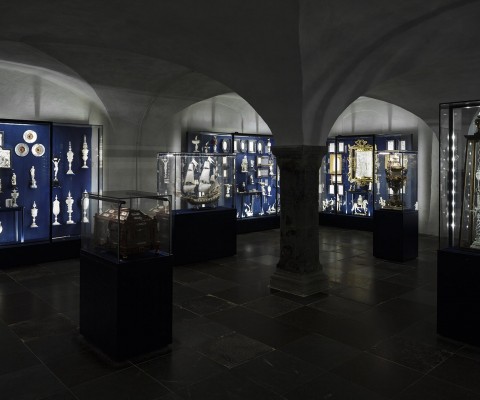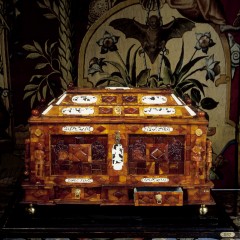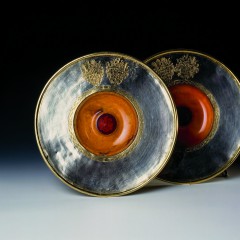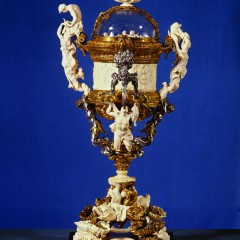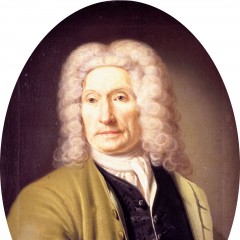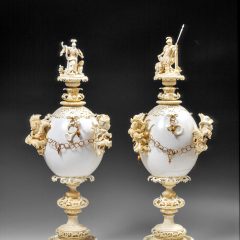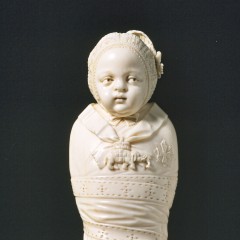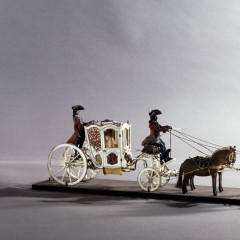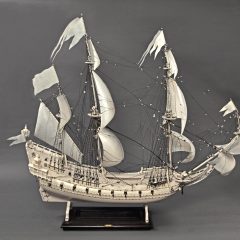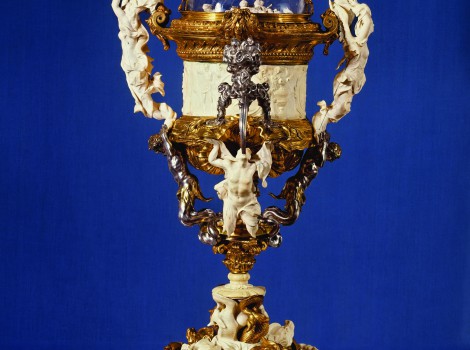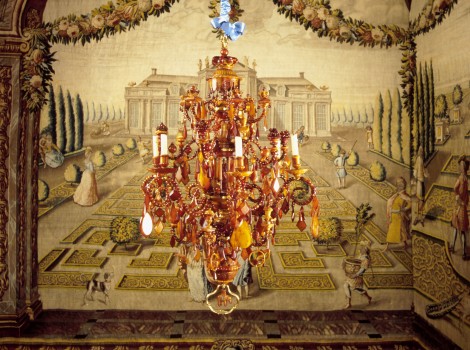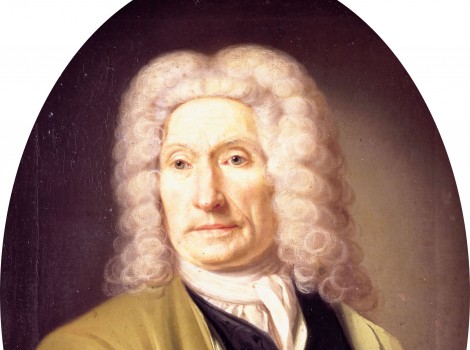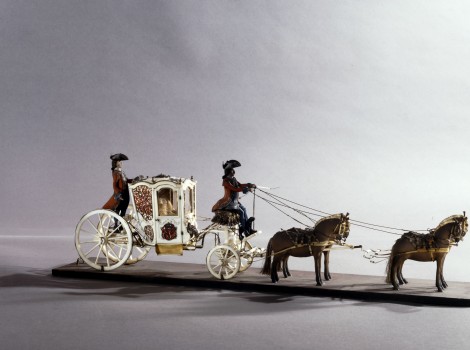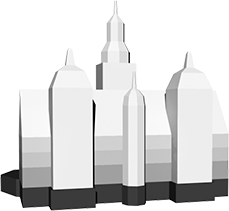C Ivory and amber
In the cellar room furthest to the north about half of Rosenborg’s 700 or so artefacts made of ivory and amber are displayed. They range in date from 1585 to1850. Some are gifts from foreign princes in return for white hunting falcons from Iceland and horses from Denmark. Some were bought in Nuremberg and Augsburg, the south German centres for luxury goods. Others are war booty from Gottorp Castle, the residence of the Dukes of Schleswig-Holstein, which was emptied in 1713.
Most of these objects were made in the 18th century, however, and this is unique among European princely collections. From the time of Frederik II until that of Frederik V all the successive kings of Denmark-Norway employed turners and carvers, several of whom belonged to the international elite.
Many of these court artists had the special responsibility of teaching members of the royal family the art of turning. It was thought that work with the lathe encouraged the pupil’s interest in mathematics and mechanics and fostered patience and planning-ability – valuable qualities for a future monarch. In Denmark this activity culminated in around 1750.
Amber was often made into objects for religious use in the Catholic era – e.g. rosaries. After the Reformation it was used for secular purposes such as caskets, objects for the table and chandeliers for princely curiosity cabinets. In around 1720 amber was supplanted by the new European porcelain, which became the latest fashion at most of the courts. Not in Copenhagen, however; here amber, “the gold of the North” kept its status.
-
Objects in this room
-
2701-2707
Six turned goblets, probably made in Nuremberg: 2701. Lobed basketwork- and lozenge- turned lidded goblet with loose rings around the cup. Around the stem a spirally-wound serpent, with carved wings and rosettes above it. On the lid an openwork border and a hollow sphere with portraits of Christ and Mary. Above, two polygonal solids with thorns, a crown and a spiral with a metal ball. Partially stained green. 1600-1650? 2702. Related goblet with different construction. In the top spiral of the lid are three metal balls. 1600-1650? 2703. Related goblet. In the hollow sphere is a coloured engraving of Christ and Mary. Threefold polygonal solids and, above, a many-sided star, turned in one piece. Partially stained green and gilded. c.1650? 2704. Lobed and lozenge-turned goblet. Stem and lid-finial in the form of a spiral staircase. In the hollow sphere is a chandelier. c.1650? 2705. Sixteen-foil diagonally fluted goblet with roses and threefold polygonal solids. 1650-70? 2706. Sixteen-foil goblet with roses. 1650-70? -
2707-2719
2707. Ivory tankard, with Christian IV’s monogram on the lid. Belonged to Hedevig, wife of Ebbe Ulfeldt and daughter of Christian IV and Kirsten Munk. Traditionally thought by the family to have been turned by Christian IV himself, c.1600, but more probably made by one of the Ulfeldt family c.1650. 2708. Oval and lobed turned cup on stand with amber finial. Turned in 1618 by Archduke Leopold of Austria (1586-1632), whose coloured coat of arms and signature can be seen with the date on the inside of the lid. 2709. Ostrich egg carved with religious scenes, the Virtues and hunting motifs. Mounted with a foot and lid of ivory in what seems to be a display of the various techniques used in the art of turning. Nuremberg, c.1650? 2710. Lidded turned goblet, lobed. Loose rings around the cup, and a hollow sphere on the lid. The short baluster stem of the foot and the spiral on the lid are probably later repairs made by Lorenz Spengler. Nuremberg 1600-50? 2711. Eight-lobed lidded goblet. The elegant curving vegetation form is known from the silversmiths’ so-called columbine cups. Nuremberg 1630-75? 2712. Eight-lobed lidded goblet with Gothic bosses. The undulating, convex-concave forms of the foot, finial and cup stand out in refined contrast to fragile ornaments on the stem and lid. Saxony or Nuremberg 1620-1650? 2713. Multi-lobed goblet with basketwork and a tall curved cup. Nuremberg c.1650? 2714. Lobed turned goblet with convex-concave forms. Related to no. 2712. 2715. Lobed turned goblet with basketwork on openwork stem. Nuremberg 1630-75? 2716. Polygonal solid with thorns and leaves, signed IE for Johann Eisenberg, Saxony. 2717. Polygon with thorns, mounted on a foot. 2718. Walking stick, turned using a variety of techniques. Gift to Christian IV in 1641 from Duke Wilhelm of Saxony-Weimar (1598-1662), who has signed the grip. The Duke employed two of the most skilled turning artists of the time, Marcus Heiden and his pupil, Johann Eisenberg. 2719. Leather whip with turned grip, containing a pomander and a whistle. Belonged to Christian V. -
2720-2727
2721. Silver plates with amber centres, made in 1585 in Kaliningrad by Andreas Knieffel for Margravine Sophia of Brandenburg, née Princess of Braunschweig and Lüneburg, Frederik II’s cousin. Amberwork by Stenzel Snitt? Housewarming present to Frederik II at Kronborg Castle? Associated with no. 5032. 2722. Marsyas and Apollo. Marsyas challenged Apollo to a contest to establish which of them played better. In retaliation Apollo flayed Marsyas alive and gave King Midas, who had voted in favour of Marsyas, donkey ears. The ivory relief, which shows how antiquity viewed the difference between gods and humans, is inscribed H O and H V (Hans Ochs in Husum) 1624. Inset above, as if it were an altarpiece, the Holstein-Gottorp coat of arms. War booty from Gottorp, 1713. 2723 Lidded cup with Bacchus and his attendant, the drunken Silenus, supported by a satyr and others. The theme, taken from Peter Paul Rubens, is intended as a warning against drunkenness and became popular on cups and tankards from Augsburg in the 1630s. The ivory carver is not known. Mounting by goldsmith Daniel I. Lang, 1635. Four statuettes, based on bronzes by Giovanni da Bologna: 2724. Venus, drying herself after bathing. By Francois Duquesnoy in the 1620s? 2725. Venus and Amor. 2726. – 2727. Venus and Apollo. Attributed to Francois Duquesnoy in the 1620s. Bases made by L.-A. Le Clerc 1751. -
2728-2733
2728. Christ at the stake. Netherlands, c.1670? 2729. Crucifix. North Germany, c.1670? 2730. Tankard of amber, carved with the Virtues and bacchanalian scenes. German inscription. Kaliningrad work, c.1650? In free-standing showcase: 2732. The frigate Norske Løve. Model, scale 1:60, carved in ivory and silver, 1651-54, by Jacob Jensen Nordmand for Frederik III. On the stern the royal coat of arms and one lantern are missing. On the wall: 2733. Portrait of Jacob Jensen Nordmand (1614 95), on wood, signed: Wolfgang Heimbach 1654. -
2736-2741
Models of galleys and boats, carved by Jacob Jensen Nordmand: 2736. – 2737. Two galleys. Made from a drawing by Cort Adeler, who fought for Venice against the Turks before becoming a Danish admiral in 1662. 2738. A speeljacht, a type of boat from the Netherlands. 2739. – 2740. Two single-masted sailing boats. 2741. Sailing boat of narwhal tusk with a gold anchor. In the bow there is a piece of iron to enable the boat to be steered by a magnet. Narwhal tusk had the reputation of being an antidote, and the boat was possibly intended to be used to purify poisoned wine. -
2742-2749
2742. Flacon of narwhal tusk with Frederik III’s monogram and the head of a Moor with pearls in his ears. Signed: I(acob) I(ensen) (Nordmand) (16)51. 2743. Cup on stand, ivory with silver gilt mounting. Decorated with battling sea creatures. On the lid a Nereid, with Neptune and Amphitrite forming the stem. South Germany, c.1670. 2744. Duke Christian Albrecht of Holstein-Gottorp. Bust carved by Joachim Henne c.1667. 2745. Duke Frederik III and Duchess Marie Elisabeth of Holstein-Gottorp. Ivory busts made by Joachim Henne, 1663-67. 2746. Drinking horn, tusk, silver gilt mounting. Frederik III’s monogram on the elephant’s blanket. Made by Bendix Grodtschilling c.1670? 2747. Tazza, silver gilt, supported by three satyrs and decorated with putti. Above, Amor, on the foot, the four elements. The figures are ascribed to Joachim Henne, the mounting to the Lambrecht family in Hamburg 1663-1667. Pendant to no. 2784. Part of a set of six (no. 2747, 2750. 2752, 2762, 2782 and 2784), probably made for Prince-Bishop August Friedrich of Lübeck. 2748. Goblet with crowned CA for Duke Christian Albrecht of Holstein-Gottorp. Turned by Caspar Zick the elder in Nuremberg in 1685? 2749. Lidded goblet of amber and ivory, supported by three putti. The figure on the lid is a crowned and partly painted swan. Made by Lorenz Spengler in 1749, with re-use of older parts. Pendant to no. 2781. -
2750-2752
2750. Tazza, silver gilt, supported by Mars and Venus. Above, two putti, a girl and a boy, crowning each other with wreaths. Playing putti on the foot. Pendant to no. 2782. Associated with no. 2747. 2751. Lobed turned beaker. On the lid Bacchus surrounded by the gods of Olympus: Mercury, Paris and Venus, Amor, Juno and Minerva. Ascribed to Joachim Henne. Silver gilt inner cup, with the stamp of Hieronimus Sværdfeger, Copenhagen 1667. 2752. Silver gilt tazza. In the bowl, relief of the Judgement of Solomon, after a painting by Peter Paul Rubens. Stem formed by the figure of Hercules in battle with Antaeus and Envy. Playing children on the foot. Pendant to 2762. Associated with no. 2747. -
2753-2761
Nine reliefs made by Joachim Henne, mainly with motifs from Ovid’s Metamorphoses: 2753. Venus tries to prevent Adonis from hunting the wild boar that would cause his death. 2754. The hunter Actaeon surprises Diana, the chaste goddess of hunting, and her nymphs while bathing. In retaliation Diana transformed him into a deer. 2755. Venus and Amor visiting Vulcan’s forge. 2756. The feast of the gods. 2757. Venus with Amor, pursued by bees. 2758. The three graces. 2759. Venus and Mars. In the foreground three bathing nymphs are holding out a pearl chain, a mussel shell and a piece of coral towards the pair of lovers. 2760. Callisto being disrobed. She was one of the nymphs of the goddess of hunting, the chaste Diana, but was impregnated by Jupiter. Diana banished her as punishment. Callisto bore Jupiter a son, whereupon Hera, Jupiter’s jealous wife, transformed her into a bear. 2761. The three graces. -
2762-2768
2762. Silver gilt tazza. In the bowl a relief of the Queen of Sheba’s visit to King Solomon. Stem formed by Hercules fighting the hydra. Playing children on the foot. Pendant to no. 2752. Associated with no. 2747. Six statuettes and busts by Joachim Henne: 2763. Mars sets off to war, while Venus, helped by Amor, tries to hold him back. 2764. Mercury, Jupiter’s messenger 2765. Leda impregnated by Zeus in the form of a swan. Foot of wood, decorated with silver ornaments; ball feet of coral. 2766. Frederik III, 1667. 2767. Christian V as Crown Prince, 1667. 2768. Queen Charlotte Amalie, 1667. -
2770-2779
2771. Heart-shaped box, carved with a rebus of Virtues, Frederik III’s monogram and inscription: May God inspire the King’s heart with justice and courage. Dated 1667. 2772. Box with lobed turned ornaments in black. According to tradition turned by Frederik III. 2773. Box with phallus, 1660s? 2774. Box with portrait of Queen Charlotte Amalie and landscape with inn, above which is a flag with Christian V’s monogram. Turned by Andoin Schæff c.1680? 2775. Box with turned ornaments in black. Made by Crown Prince Frederik (IV) as an 11-year-old in 1682. 2776. Box containing small boxes. Turned by Crown Prince Frederik (IV) and presented to Christian V at New Year 1691. 2777. Box with wax relief of Pope Innocent XI (1611-89). Made by Ulrik Christian Gyldenløve, son of Christian V and his official mistress, Sophie Amalie Moth, in 1692. -
2780-2789
2781. Ivory and amber goblet. Pendant to no. 2749. 2782. Silver gilt tazza, supported by Daphne and Apollo. Pendant to no. 2750. Associated with no. 2747. 2783. Ivory goblet with a triumphant emperor, probably Leopold I after the victory over the Turks at Vienna in 1683. 2784. Silver gilt tazza, supported by three nymphs. Above, a putto with a crown in its hands. Pendant to no. 2747. 2785. Lidded goblet with half-moon and Turk’s head on the foot. From the Zick-workshop in Nuremberg, c.1680? 2786. Ivory drinking horn with silver gilt mounting with engraved flowers. The foot is supported by three elephants. Pendant to no. 2746. 2787. Cup on stand, rhinoceros horn, with two Bacchus-figures of ivory. Hunting scene on the cup. South Germany c.1700. 2788. Turned goblet with carved rural scene. Made by Gottfried Wolffram c.1690? 2789. Box with carved rural scene. On the lid, the Virgin Mary with Jesus. Made by Gottfried Wolffram c.1690? -
2801-2813
Objects carved by Magnus Berg: 2801. The Deposition from the Cross, dated 1711. 2802. The slaying of children in Bethlehem. 2803. Matthew. 2804. Mark. 2805. Luke. 2806. John. 2807. The apotheosis of Frederik IV. Made in 1728-30. 2808. John baptizes Jesus. 2809. Moses sets up the serpent of brass in the wilderness, dated 1719. 2810. Peter. 2811. Judas. 2812. Hermit, reading, with skull. 2813. Hermit, reading. -
2814-2823
So-called “combination-figures” of ivory and exotic types of wood, probably made by Simon Troger, who founded a workshop in Haidhausen near Munich in c.1732: 2814. Beggars, bought in 1733. 2815. Equestrian statuette of Frederik IV, bought in 1733. 2816. Beggars, bought in 1735. 2817. Two janissaries, mounted in gilt metal with rose-cut diamonds, garnets and cameos. Probably bought in Dresden by Frederik IV as a present for his sister, Princess Sophie Hedevig. 2818. Frederik IV on horseback. Relief in an amber wreath, inscribed: I(acob) D(obbermann), c.1710? 2819. The goddess of wisdom with Frederik IV’s portrait and the owl at her feet. Jacob Dobbermann, Kassel, before 1718? 2822. “The Water”, a large ornamental vase of silver, bronze and ivory. Magnus Berg’s largest work, from 1708-23, but not assembled until after his death. 2823. Magnus Berg at an advanced age. Portrait by an unknown artist. -
2826-2835
Unless otherwise indicated these objects are considered to have been made by Lorenz Spengler, while the ivory figures are ascribed to J. E. Bauert: 2826. Plain lidded goblet, amber finial on the lid. 2827. Ewer, coconut, with spiral fluting and a lion handle, 1749. Pendant to no. 2857. 2828. Plain oval lidded goblet, horned monkey on the lid, 1751. Pendant to no. 2858. 2829. Vase of coconut with spiral fluting and a crown on the lid. Pendant to no. 2853. 2830. Basketwork goblet with two doves on the lid. Pendant to no. 2854. 2831. Plain goblet with a fox, an amber ball and a crown on the lid. Pendant to no. 2855. 2832. Lobed goblet with spiral turned stem and finial. 2833. Spiral-fluted ewer of coconut with a sphinx as spout and a dragon as handle, 1749. Pendant to no. 2851. 2834. Bowl on stand, amber and gilt wood, representing the pleasures of the hunt: a chained swan, fire-breathing snakes, a dog and a deer’s head, 1750. See also no. 2852. 2835. Lobed goblet, encircled by a movable serpent. On the cover an open crown, in which there was previously a closed crown with Christian VI’s and Queen Sophie Magdalene’s monograms. Made in 1730-1734. -
2836-2846
Turned pieces made by royal personages under the guidance of Spengler: Christian VI: 2836. Silver gilt box with rose-turned disc of amber. 2837. Basketwork-turned box. The edge of the lid is lobed, the centre rose-turned. This box and the previous one come from the estate of Queen Sophie Magdalene and were probably gifts from Christian VI. Sophie Caroline, Princess of East Friesland, sister of Queen Sophie Magdalene: 2838. Doll’s table Frederik V: 2839. Amber balsam box, 1739. 2840. Box. In the lid is an amber plaque, under which there is the impression of a ducat with Frederik V’s portrait. Made by M.G. Arbien in 1746. 2841. Box, originally red-stained, in silver gilt mounting. In the lid is an amber plaque. Queen Louise: 2842. Chandelier with 16 arms in two tiers. 2843. Chandelier with eight arms. 2844. Spinning wheel. 2845. Chinese tower with 11 stories on an ebony foot. 2846. Spiral staircase. The foot is Lorenz Spengler’s work. -
2850-2858
2850. Plain goblet on a spiral foot. On the lid a crown. 2851. Ewer of coconut with spiral fluting. Pendant to no. 2833. 2852. Bowl on stand with a dragon on a lobed bowl, supported by a tree, and beneath it a monkey with a Chinese hat and an elephant head. Exotic pendant to no. 2834. 2853. Spiral-fluted vase of coconut. Pendant to no. 2829. 2854. Basketwork goblet. Pendant to no. 2830. 2855. Plain goblet. Pendant to no. 2831. 2856. Plain goblet on triple spiral. Amber finial on the lid. 2857. Ewer, coconut. Pendant to no. 2827. 2858. Oval, plain goblet, on the lid a bear with ham. Pendant to no. 2828. -
2859-2867
2859. – 2860. Two statuettes of Mercury and Apollo. Made by Johan Christoph Petzold in 1760? 2863. Coach of ivory with silver filigree, with four-in-hand and figures of papier-maché. Frederik V’s monogram on the doors. Signed: D(iderich) de Thurah A(nno) 1749. 2866. – 2867. Two statuettes of Apollo and Neptune. The latter a reduced copy of the statue in front of the Copenhagen Bourse. Made by Johan Christoph Petzold in 1761? -
2870-2879
Unless otherwise indicated these objects are considered to have been made by Lorenz Spengler, while the ivory figures are ascribed to J. E. Bauert: 2870. Two vases of ostrich eggs with swans and satyrs respectively, 1752. 2871. Pair of vases of ostrich eggs, with putto and ewer, and putto and ostrich egg respectively, 1754. The eggs come from the deer garden at Frederiksberg Palace, where Frederik V kept a number of ostriches that the Emperor of Morocco had sent him as a present in 1753. 2872. Pair of vases of ostrich eggs with a bear fighting an ox on one, and a dog fighting a wild boar on the other. 2873. Flacon, brown and yellow amber, shaped into organic-amorphous forms, 1750. Pendant to no. 2892. 2874. Plain lobed goblet, turned by Frederik V’s valet N.J. Jessen for the King’s birthday on 31.3.1756. Pendant to no. 2893. 2875. Bowl on stand, amber on a foot of gilt wood, shaped into organic-amorphous forms, 1754. Pendant to no. 2894. 2876. Basketwork and lobed goblet, originally red-stained. Two cats on the lid, 1752. Pendant to no. 2895. 2877. Stand with turned portrait medallion of Frederik V and his second wife, Queen Juliane Marie, signed by Lorenz Spengler. On the sides putti with symbols of the King’s motto “By Wisdom and Constancy”. Made for the King’s birthday in 1755. 2878. Denmark and Norway paying homage to Frederik V. The foot was originally red-stained. Made for the King’s birthday in 1758. 2879. Lobed and basketwork turned goblet with dolphin. Pendant to no. 2891. -
2880-2889
Unless otherwise indicated these objects are considered to have been made by Lorenz Spengler, while the ivory figures are ascribed to J. E. Bauert: 2880. Openwork vase, partly basketwork, with dragons as handles. Above, Fortuna, the goddess of fortune, standing on a globe and holding the sun in her hands. The foot ring is inscribed: “L. Spengler. Tourneur de S. M. le Roy. 1752″. 2881. Bust of shepherdess, 1754. The shepherd companion-piece was destroyed in the fire at Christiansborg Palace in 1794. 2882. Bust of satyr, 1754. 2883. – 2884. Pair of statuettes, Mercury playing the flute and the nymph Io. Mercury signed J. E. B. for Johann Ephraim Bauert 1757. 2885. “The glorification of the chase”, bowl on stand, ivory, lapis lazuli, jasper etc. Above, Diana, the goddess of hunting. Below, one of her nymphs with a dog, flanked by Atalanta, who was the first to strike the feared Calydonian boar, and by Meleager, who killed the boar. The ivory ornaments on the pillar are signed by J. E. Bauert, 1750. 2886. Turned medallion with Frederik V’s portrait. Probably a trial piece, since L. Spengler’s initials are partly covered by the King’s Elephant Order. 2887. Postilion, carved by Jørgen Christensen Garnaas, who drove out with the post around Bergen in Norway, c.1760. 2888. Altar of ebony, tortoiseshell and ivory. Above, Christ at the stake and being scourged, below, Mary holding up a cloth in front of her face in lamentation, 1751. 2889. Stand with turned portrait of Frederik V, intended as a pendant to no. 2877. Made for the King’s birthday in 1759. In the drawer, a poem of homage to the royal couple from Lorenz Spengler. -
2890-2899
Unless otherwise indicated these objects are considered to have been made by Lorenz Spengler, while the ivory figures are ascribed to J. E. Bauert: 2890. Apollo and the Arts paying homage to Frederik V. Made for the King’s birthday, 1758, by J.E. Bauert. 2891. Goblet with dragon. Pendant to no. 2879. 2892. Flacon, amber. Pendant to no. 2873. 2893. Goblet. Pendant to no. 2874. 2894. Bowl on stand, amber. Pendant to no. 2875. 2895. Goblet, originally red-stained. Pendant to no. 2876 2896. Pair of vases of ostrich egg, with Minerva and Mars respectively as symbols of Frederik V’s motto: “By Wisdom and Constancy”, 1757. 2897. Pair of vases of ostrich egg, one with a dog fighting a deer and the other with an eagle fighting a hare, 1757. 2898. Pair of vases of ostrich egg, one with a tiger fighting an ostrich and the other with an ostrich fighting a lizard. 2899. Artistic showpiece, a spiral staircase, turned in ivory, amber and tortoiseshell by J.C. Opitz, 1782. -
2901-2910
Unless otherwise indicated these objects are considered to have been made by Lorenz Spengler, while the ivory figures are ascribed to J. E. Bauert: 2901. Pair of urn-shaped vases with amber finials, c.1760. 2902. Busts of Frederik V and Queen Juliane Marie, the latter wearing the Order of l’Union Parfaite. Made by J. E. Bauert c.1760. 2903. Temple with an openwork sphere with thorns, inscribed: (crowned) J. M. (i.e. Juliane Marie) fecit Ao 1754. 2904. Four turned boxes of tortoiseshell, ivory and walrus tusk, mounted in gold or gilt metal, all inscribed: (crowned) J. M. (i.e. Juliane Marie) fecit. 2905. The Heir Presumptive, Prince Frederik. Figure of a baby in swaddling clothes, partially painted ivory, by Johann Christoph Ludwig Lücke, Copenhagen 1753-54. The Heir Presumptive was Queen Juliane Marie’s only child. 2906. Woman with urn, symbol of piety. Made for Frederik V’s birthday in 1761. 2907. Triumphal arch of ebony, tortoiseshell and ivory etc. Made on the occasion of the centenary of the introduction of Absolutism. Inscribed: L. Spengler 16 October 1760. Above the balustrade two turned medallions with a portrait of Frederik III and an allegory of Absolutism, both inscribed: Spengl. In the portal a bust of Frederik V, made by J. E. Bauert. 2908. Tripod vase, decorated with goats’ legs, elephant-heads and a satyr embracing a nymph. Birthday present for Frederik V, 1760. 2909. Pendant, crowned, with Triton and siren. Birthday present for Frederik V, 1763. 2910. Tripod vase, supported by caryatids and crowned by a child with a turkey cock. The upper part includes a re-used box with carved rural scenes, made by A. Schæff c.1690, which Princess Charlotte Amalie had given to Frederik V in 1750. Birthday present to the King, 1764. -
2911-2914
Seven statuettes, supplied by Spengler, but carved by an unknown artist:: 2911. Statuette of Diana with a hound. Made to commemorate the abolition of hunting on horseback in 1761. Birthday present for Frederik V, 1763. 2912. Pair of statuettes, one representing Amor, the other a girl with a flower. 2913. Pair of statuettes, one representing boys fighting over a conch, the other Ganymedes fighting with Jupiter, who had transformed himself into an eagle. Probably symbols of innocence and desire. Made in 1761. 2914. Pair of statuettes of boys playing with a squirrel and a parrot. Made in 1762. -
2915-2921
Turned artefacts made by Frederik V’s nephews, Landgraves Wilhelm (1743-1821), Carl (1744-1836) and Friedrich (1747-1837) of Hesse, who were partly educated at the Danish court: 2915. Two goblets with amber finials, signed respectively by Wilhelm and Carl. Birthday presents for Frederik V, 1759. 2916. Temple with bust of Frederik V. The temple signed by Landgrave Wilhelm, the bust made by I. E. Bauert. Birthday present for Frederik V, 1760. 2917. Pair of vases with turkey-eggs and amber finials, signed by Carl and Friedrich respectively. Birthday presents for Dowager Queen Sophie Magdalene on 28.11.1760. 2918. Cylindrical yarn-holder, in the shape of a barrel, for carrying on a belt. Made by Landgrave Wilhelm and given to Dowager Queen Sophie Magdalene.. 2919. Vase with amber finial, signed by Landgrave Friedrich. Birthday present for Frederik V, 1760. 2920. Two flacons and a table of turned amber, signed by Wilhelm, Carl and Friedrich respectively. Gifts to Dowager Queen Sophie Magdalene, 1759. 2921. Justice. Pendant to a now lost statuette of Love. New Year presents for Frederik V, 1764. Transferred to the Kunstkammer on 3.1.1765. -
2930-2939
2930. Chandelier with 16 arms of gilt metal. Above, an eagle; inlaid reliefs with allegorical figures and etched foliage on the central sphere. Königsberg, c.1600. A present from Christian IV’s Brandenburg relations by marriage? 2931. Mirror with royal crown. Presumably made by Gottfried Wolffram c.1707, possibly originally meant for the amber room in the Catherine Palace at Tsarskoe Selo. 2932. Crucifix. North Germany 1675-1700. Restored by Lorenz Spengler 1750s?. 2933. Casket in two tiers with figures and reliefs in ivory. North Germany c.1675? 2934. Crucifix with figures of Mary and John, with reliefs including depictions of Christ in the Garden of Gethsemane and the Last Supper. North Germany c.1675? Restored by Lorenz Spengler in 1750. 2935. Pair of vases with lion masks, female hermae and foliage. Kaliningrad c.1650? 2936. Amber bowl with ivory relief of Jupiter and Callisto (cf. no. 2760). Kaliningrad c.1650. 2937. Twelve-lobed bowl with handle in the form of foliage. North Germany, c.1640? 2938. Snuff-horn with carved equestrian scene. North Germany, c.1675? 2939. Mussel-shaped cup on stand. North Germany, c.1640? -
2940-2949
2940. Centre piece, composed of a lidded beaker from c.1650. Engraved fruits and foliage on the sides, in the base a German verse about moderation as the path to salvation. With an added openwork foot with a putto carved from one piece of ivory, probably by J. E. Bauert. Delivered by Lorenz Spengler in 1750. 2941. Flacon, carved with cupids and fruits in high relief. Christoph Labhart, Kassel, c.1690? 2942. Mussel-shaped cup on stand with Venus and Amor. Christoph or Johann Caspar Labhart, Kassel, 1690-1700? 2943. Box, carved in high relief: on the upper side of the lid, Orpheus playing for the animals, and underneath a portrait in a laurel wreath of Landgravine Maria Amalie of Hessen? Acanthus decoration on the box. Christoph Labhart, Kassel, c.1690? 2944. Burning-glass, set in metal. North Germany, c.1680? 2945. Burning-glass with arm as handle. North Germany, c.1680? 2946. Syringe. North Germany, c.1680? 2947. Watchman’s whistle with mouthpiece of ivory and compartment at the top end. 2948. Turned flute with four holes. Copenhagen, c.1750? 2949. Turned miniature-beaker with wave-ornamentation, twelve-lobed foot and rosette underneath the foot. Copenhagen, c.1750? -
2950-2959
2950. Yarn-reel. Copenhagen, c.1750? 2951. Thimble. Copenhagen, 1820s. 2952. Etui with scissors. North Germany, c.1730. 2953. Chess set of earlier date, with chess- and draughts-pieces, probably restored by Lorenz Spengler c.1750. 2954. Amber food container. North Germany, c.1720? 2955. Chest of drawers, engraved with crown and “LOU” for Frederik V’s Queen Louise. Copenhagen, 1745-51. 2956. Model of naval ship “Anna Sophia”, named after Frederik IV’s second wife. Made by Diderich de Thurah, 1723. 2957. Casket, containing four smaller caskets for playing cards and tokens, inlaid with engraved rural scenes and French inscriptions. North Germany, c.1720? 2958. Pair of flacons in gold mounting. Lorenz Spengler, 1745-50. 2959. Bust of Christian VI, carved by Johan Lorenz Natter, 1743-44. -
2960-2969
2960. Flacon with rocaille ornamentation. Lorenz Spengler, c.1750. 2961. Vase with rocaille ornamentation and gold mounting. Lorenz Spengler, c.1750. 2962. – 2963. Pair of statuettes with putti on a pedestal of green-stained ivory. Symbols of Frederik V’s motto: Through Wisdom and Constancy. Lorenz Spengler, 1755. 2964. Bowl on stand with organic-amorphous carving on a traditional foot. Lorenz Spengler 1750-55. 2965. Box with Neptune and sea-monsters. North Germany, c.1730? 2966. Box in the form of the wheel of a ship. Engraved on the inner side with Christian VI’s and Queen Sophie Magdalene’s crowned monogram. 2967. Box with carved crowned F(rederik V) and L(ouise), together with Danish and English coats of arms. Probably made for the Crown Prince’s wedding in 1743. On the back, the signature: H. C. Wernicke. Possibly made in London, since the Danish coat of arms is not correctly represented. 2968. Box with carved mussel. North Germany, c.1730? 2969. Turned oval box. The rounded shapes are reminiscent of Diderich de Thurah’s writing set from 1734 (no. 2980). -
2970-2983
2970. Vertically fluted box with gold mounting. Copenhagen, 1740s? 2971. Box with gold mounting, a ruby, a sapphire, an emerald and diamonds. Copenhagen c.1750? 2972. Flacon in the shape of a tree-stump with branches and birds. Lorenz Spengler, 1761. 2973. Vinaigrette with carved flowers and gold mounting. Lorenz Spengler, c.1760? 2974. Three containers for toothpicks. North Germany, c.1730? 2977. Box in the shape of a bass viol, mounted with gilt metal and amethysts. North Germany, c.1730? 2978. Heart-shaped vinaigrette with carved and engraved royal crowns; the engraving is probably the work of Queen Louise. 2979. Vinaigrette with gold mounting. Copenhagen, c.1760? 2980. Writing set on a tortoiseshell tray, made by Diderich de Thurah, 1734. 2983. Casket with warriors carved in amber and ivory reliefs of pastoral scenes etc. North Germany. Probably the casket costing 800 rigsdaler which the newly-married Crown Princess Louise was given as a Christmas present in 1695. -
2986-2990
Søren Seidelin Winther (1810-47): 2986. Statuette of Minerva. Signed by Søren Seidelin Winther, Rome 1844. 2987. Frederik VI and Queen Marie Sophie Frederikke. Exhibited at Charlottenborg 1840. 2988. Christian VIII and Queen Caroline Amalie. Exhibited in 1842. 2989. Crown Prince Frederik VII and Crown Princess Mariane, 1841. 2990. Goblet with a procession including Bacchus riding on a donkey. Made by S. S. Winther in Rome, 1843-47. -
2991-2999
2991. Pair of candle-sticks. From Dowager Queen Caroline Amalie’s estate. 2992. Equestrian statuette of Frederik VI at an advanced age, on a base of tortoiseshell. Made by Fischer Hertz and exhibited at Charlottenborg in 1844. 2993. Bust of Christian VIII. Unknown artist, 1830s? 2994. Photograph of Dowager Queen Caroline Amalie from around 1870, in a contemporary frame with her monogram and coat of arms. 2995. Box, inscribed H. G(ardthausen)1840. On the lid there is a bellowing stag, carved from an engraving by I. E. Riedinger from 1736. On the side a contemporary fox-hunt, depicted with almost photographic realism. 2996. Powder horn with hunting scenes, probably carved by H. Gardthau¬sen, who was employed by Court Turner Schwartz. The silver mounting is engraved with the crowned initials F.C.C. and 1847, for Frederik VII as Crown Prince. Three animal statuettes, all made by Adelgunde Vogt, née Herbst (1811-92): 2997. Stag lying on a base of patinated brass. Ordered by Christian VIII during a visit to the artist’s workshop in 1840 and exhibited at Charlottenborg in 1841. 2998. Standing hind on a bronze base, in which there are holes for attaching a now-missing calf. Ordered by Christian VIII in 1842. 2999. Stag (with antlers missing) and hind on a base of gilt brass. Seen by Christian VIII during a visit to the artist’s workshop in 1844, exhibited at Charlottenborg in 1844 and bought by the Museum for Sculpture and Handicrafts.

 Dansk
Dansk
 English
English
 Deutsch
Deutsch

